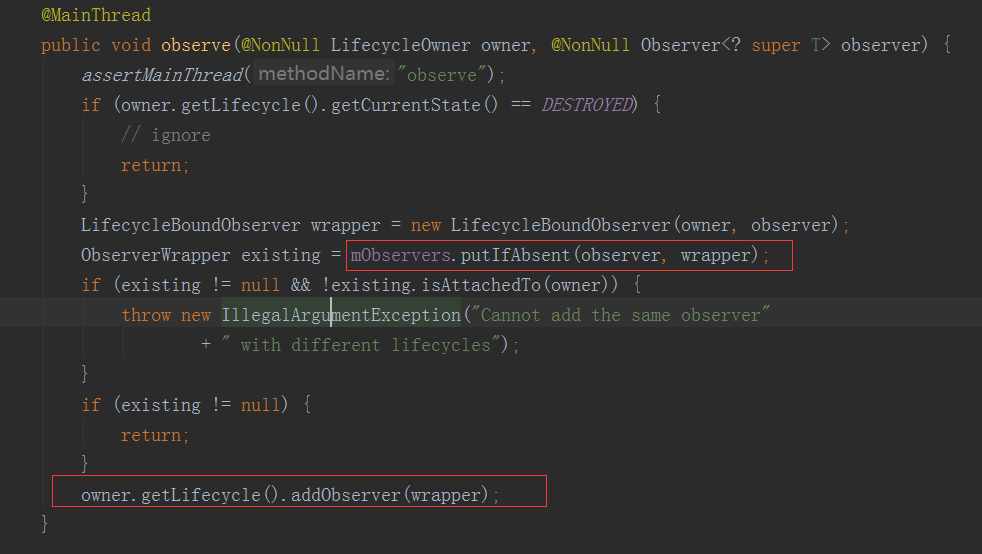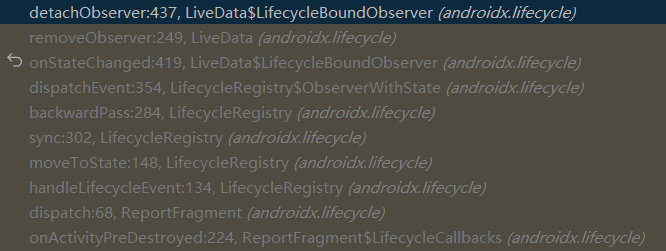Jetpack的ViewModel与LiveData
本文基于SDK 29
一、ViewModel与LiveData的作用:
1、viewModel:
数据共享,屏幕旋转不丢失数据,并且在Activity与Fragment之间共享数据。
2、LiveData:
感知生命周期并且通知观察者刷新,防止内存泄漏。
二、用法
三、原理:
1、ViewModel:
ViewModelProviders.of(this).get(MyViewModel::class.java)
我们通过这个方法来构造ViewModel。
@NonNull
@MainThread
public static ViewModelProvider of(@NonNull FragmentActivity activity) {
return of(activity, null);
}
/**
* Creates a {@link ViewModelProvider}, which retains ViewModels while a scope of given Activity
* is alive. More detailed explanation is in {@link ViewModel}.
* <p>
* It uses the given {@link Factory} to instantiate new ViewModels.
*
* @param activity an activity, in whose scope ViewModels should be retained
* @param factory a {@code Factory} to instantiate new ViewModels
* @return a ViewModelProvider instance
*/
@NonNull
@MainThread
public static ViewModelProvider of(@NonNull FragmentActivity activity,
@Nullable Factory factory) {
Application application = checkApplication(activity);
if (factory == null) {
factory = ViewModelProvider.AndroidViewModelFactory.getInstance(application);
}
return new ViewModelProvider(activity.getViewModelStore(), factory);
}
从源码中可以看出,ViewModelProviders.of(this)获取了一个ViewModelProvider 对象,而该对象中持有一个ViewModelProvider.AndroidViewModelFactory(因为我们传进入的是null)
和activity.getViewModelStore()。
private final Factory mFactory;
private final ViewModelStore mViewModelStore;
public ViewModelProvider(@NonNull ViewModelStore store, @NonNull Factory factory) {
mFactory = factory;
this.mViewModelStore = store;
}
我们再来看看ViewModelStore这个类,从名字中已经可以看出它的用途,那便是存储ViewModel。
public class ViewModelStore {
private final HashMap<String, ViewModel> mMap = new HashMap<>();
final void put(String key, ViewModel viewModel) {
ViewModel oldViewModel = mMap.put(key, viewModel);
if (oldViewModel != null) {
oldViewModel.onCleared();
}
}
final ViewModel get(String key) {
return mMap.get(key);
}
/**
* Clears internal storage and notifies ViewModels that they are no longer used.
*/
public final void clear() {
for (ViewModel vm : mMap.values()) {
vm.onCleared();
}
mMap.clear();
}
}
我们的ViewModel便是存储在上面的HashMap中。
接下来我们再来看ViewModelProviders.of(this).get(MyViewModel::class.java)的get方法:
@NonNull
@MainThread
public <T extends ViewModel> T get(@NonNull Class<T> modelClass) {
String canonicalName = modelClass.getCanonicalName();
if (canonicalName == null) {
throw new IllegalArgumentException("Local and anonymous classes can not be ViewModels");
}
return get(DEFAULT_KEY + ":" + canonicalName, modelClass);
}
@NonNull
@MainThread
public <T extends ViewModel> T get(@NonNull String key, @NonNull Class<T> modelClass) {
ViewModel viewModel = mViewModelStore.get(key);
if (modelClass.isInstance(viewModel)) {
//noinspection unchecked
return (T) viewModel;
} else {
//noinspection StatementWithEmptyBody
if (viewModel != null) {
// TODO: log a warning.
}
}
viewModel = mFactory.create(modelClass);
mViewModelStore.put(key, viewModel);
//noinspection unchecked
return (T) viewModel;
}
可以看出,所以会去存储ViewModel的ViewModelStore中拿,发现已经有了便直接返回,如果没有的话,那边使用mFactory工厂进行构建,然后再放进ViewModelStore中。
从之前的分析可以看出,这里的mFactory便是AndroidViewModelFactory。
@NonNull
@Override
public <T extends ViewModel> T create(@NonNull Class<T> modelClass) {
if (AndroidViewModel.class.isAssignableFrom(modelClass)) {
//noinspection TryWithIdenticalCatches
try {
return modelClass.getConstructor(Application.class).newInstance(mApplication);
} catch (NoSuchMethodException e) {
throw new RuntimeException("Cannot create an instance of " + modelClass, e);
} catch (IllegalAccessException e) {
throw new RuntimeException("Cannot create an instance of " + modelClass, e);
} catch (InstantiationException e) {
throw new RuntimeException("Cannot create an instance of " + modelClass, e);
} catch (InvocationTargetException e) {
throw new RuntimeException("Cannot create an instance of " + modelClass, e);
}
}
return super.create(modelClass);
}
其实该工厂也只是直接实例出该类而已。
此时我们便已经拿到了ViewModel。
可是它是怎么做到旋转屏幕的时候数据共享的呢。
@NonNull
@MainThread
public static ViewModelProvider of(@NonNull FragmentActivity activity,
@Nullable Factory factory) {
Application application = checkApplication(activity);
if (factory == null) {
factory = ViewModelProvider.AndroidViewModelFactory.getInstance(application);
}
return new ViewModelProvider(activity.getViewModelStore(), factory);
}
在获取ViewModelProvider的时候传进去了activity.getViewModelStore(),那我们看一下activity.getViewModelStore()是怎么获取ViewModelStore的。
@NonNull
@Override
public ViewModelStore getViewModelStore() {
if (getApplication() == null) {
throw new IllegalStateException("Your activity is not yet attached to the "
+ "Application instance. You can't request ViewModel before onCreate call.")
}
if (mViewModelStore == null) {
NonConfigurationInstances nc =
(NonConfigurationInstances) getLastNonConfigurationInstance();
if (nc != null) {
// Restore the ViewModelStore from NonConfigurationInstances
mViewModelStore = nc.viewModelStore;
}
if (mViewModelStore == null) {
mViewModelStore = new ViewModelStore();
}
}
return mViewModelStore;
}
关键的代码在于这一句:NonConfigurationInstances nc = (NonConfigurationInstances) getLastNonConfigurationInstance();
static final class NonConfigurationInstances {
Object activity;
HashMap<String, Object> children;
FragmentManagerNonConfig fragments;
ArrayMap<String, LoaderManager> loaders;
VoiceInteractor voiceInteractor;
}
/* package */ NonConfigurationInstances mLastNonConfigurationInstances;
@Nullable
public Object getLastNonConfigurationInstance() {
return mLastNonConfigurationInstances != null
? mLastNonConfigurationInstances.activity : null;
}
将mLastNonConfigurationInstances.activity强转成FragmentActivity中的一个类:NonConfigurationInstances,然后获取ViewModelStore
static final class NonConfigurationInstances {
Object custom;
ViewModelStore viewModelStore;
FragmentManagerNonConfig fragments;
}
getLastNonConfigurationInstance就是获取Activity的mLastNonConfigurationInstances对象。mLastNonConfigurationInstances的作用是当屏幕旋转或者配置更改导致Activity发生重建的时候,将上一次的非配置实例传递给新创建的Activity实例,以便恢复之前的状态。
如果mLastNonConfigurationInstances存在,那么就说明Activity是由于配置更改或者旋转屏幕导致了重建,直接从其中获取ViewModelStore,ViewModelStore保存着上一次的ViewModel,因此做到不重新创建ViewModel
销毁:
getLifecycle().addObserver(new LifecycleEventObserver() { @Override public void onStateChanged(@NonNull LifecycleOwner source, @NonNull Lifecycle.Event event) { if (event == Lifecycle.Event.ON_DESTROY) { // Clear out the available context mContextAwareHelper.clearAvailableContext(); // And clear the ViewModelStore if (!isChangingConfigurations()) { getViewModelStore().clear(); } } } });
调用路径如下:

依赖于LifeCycle
2、LivaData
我们先看这个语句:
viewModel?.livaData?.observe(this, Observer<Int> { integer -> Log.d("MainActivity", integer!!.toString()) })
从这个语句往源码里面探究:
@MainThread
public void observe(@NonNull LifecycleOwner owner, @NonNull Observer<? super T> observer) {
assertMainThread("observe");
if (owner.getLifecycle().getCurrentState() == DESTROYED) {
// ignore
return;
}
LifecycleBoundObserver wrapper = new LifecycleBoundObserver(owner, observer);
ObserverWrapper existing = mObservers.putIfAbsent(observer, wrapper);
if (existing != null && !existing.isAttachedTo(owner)) {
throw new IllegalArgumentException("Cannot add the same observer"
+ " with different lifecycles");
}
if (existing != null) {
return;
}
owner.getLifecycle().addObserver(wrapper);
}
如果这个activity处于销毁状态,那么便不会添加该观察者,否则,构造一个LifecycleBoundObserver对象,放进mObservers里面,mObservers即为:
private SafeIterableMap<Observer<? super T>, ObserverWrapper> mObservers =
new SafeIterableMap<>();
然后将LifecycleBoundObserver对象放进LifecycleRegistry里面。
LifecycleBoundObserver里面持有的对象如下:

当我们给LiveData设置值的时候:livaData.value = i
public class MutableLiveData<T> extends LiveData<T> {
@Override
public void postValue(T value) {
super.postValue(value);
}
@Override
public void setValue(T value) {
super.setValue(value);
}
}
里面还有个postValue方法:
protected void postValue(T value) {
boolean postTask;
synchronized (mDataLock) {
postTask = mPendingData == NOT_SET;
mPendingData = value;
}
if (!postTask) {
return;
}
ArchTaskExecutor.getInstance().postToMainThread(mPostValueRunnable);
}
postValue最终也会调用到主线程。postValue可以在子线程调用,而setValue必须在主线程调用,否则会抛出异常。
我们看setValue方法:
@MainThread
protected void setValue(T value) {
assertMainThread("setValue");
mVersion++;
mData = value;
dispatchingValue(null);
}
void dispatchingValue(@Nullable ObserverWrapper initiator) {
if (mDispatchingValue) {
mDispatchInvalidated = true;
return;
}
mDispatchingValue = true;
do {
mDispatchInvalidated = false;
if (initiator != null) {
considerNotify(initiator);
initiator = null;
} else {
for (Iterator<Map.Entry<Observer<? super T>, ObserverWrapper>> iterator =
mObservers.iteratorWithAdditions(); iterator.hasNext(); ) {
considerNotify(iterator.next().getValue());
if (mDispatchInvalidated) {
break;
}
}
}
} while (mDispatchInvalidated);
mDispatchingValue = false;
}
这里我们传进来的initiator为null,所以我们主要看:
for (Iterator<Map.Entry<Observer<? super T>, ObserverWrapper>> iterator =
mObservers.iteratorWithAdditions(); iterator.hasNext(); ) {
considerNotify(iterator.next().getValue());
if (mDispatchInvalidated) {
break;
}
}
这里的mObservers即为:
private SafeIterableMap<Observer<? super T>, ObserverWrapper> mObservers =
new SafeIterableMap<>();
里面存放着我们之前放进去的LifecycleBoundObserver对象。
iterator.next().getValue()获取的便是LifecycleBoundObserver对象。
private void considerNotify(ObserverWrapper observer) {
if (!observer.mActive) {
return;
}
// Check latest state b4 dispatch. Maybe it changed state but we didn't get the event yet.
//
// we still first check observer.active to keep it as the entrance for events. So even if
// the observer moved to an active state, if we've not received that event, we better not
// notify for a more predictable notification order.
if (!observer.shouldBeActive()) {
observer.activeStateChanged(false);
return;
}
if (observer.mLastVersion >= mVersion) {
return;
}
observer.mLastVersion = mVersion;
//noinspection unchecked
observer.mObserver.onChanged((T) mData);
}
检测当前生命周期,至少是处于start。
@Override
boolean shouldBeActive() {
return mOwner.getLifecycle().getCurrentState().isAtLeast(STARTED);
}
然后执行observer.mObserver.onChanged((T) mData);回调出去。
observer.mObserver便是我们传进去的观察者:
Observer<Int> { integer -> Log.d("MainActivity", integer!!.toString()) }
由以上也可以看出:我们是可以注册多个观察者的,所以要注意在一个Activity中只能够注册一次,否则会发生多个回调。
那么有个疑问,我们这样已经实现了,那问什么在liveData?.observe方法里面,不但将LifecycleBoundObserver放进LiveData的SafeIterableMap里面,还要将其放入LifecycleRegistry
里面。owner.getLifecycle()获取到的便是LifecycleRegistry

这是为了在相关的生命周期内做相关的操作,根据上一篇文章,我们可以知道,当activity的生命周期发生改变的时候,会获取添加进LifecycleRegistry的观察者,然后对每个观察者进行回调处理。
而在这里便会回调LifecycleBoundObserver的onStateChanged方法。
@Override public void onStateChanged(@NonNull LifecycleOwner source, @NonNull Lifecycle.Event event) { if (mOwner.getLifecycle().getCurrentState() == DESTROYED) { removeObserver(mObserver); return; } activeStateChanged(shouldBeActive()); }
判断如果当前处于DESTROYED状态,那么便将我们添加进入的观察者移除。调用路径如下,其实还是依赖于lifeCycle:

否则会调用activeStateChanged(shouldBeActive())方法。

如果当前的活跃状态与上一次一样,那么就直接返回。
否则如果变为活跃的状态,那么会调用dispatchingValue(this);

这里要注意,我们之前调用LiveData的setValue的时候,走的的2,但是现在走的是1,因为这次传进来的参数不为空。
private void considerNotify(ObserverWrapper observer) { if (!observer.mActive) { return; } // Check latest state b4 dispatch. Maybe it changed state but we didn't get the event yet. // // we still first check observer.active to keep it as the entrance for events. So even if // the observer moved to an active state, if we've not received that event, we better not // notify for a more predictable notification order. if (!observer.shouldBeActive()) { observer.activeStateChanged(false); return; } if (observer.mLastVersion >= mVersion) { return; } observer.mLastVersion = mVersion; observer.mObserver.onChanged((T) mData); }
然后进入considerNotify这个方法,里面有一个判断十分重要:
if (observer.mLastVersion >= mVersion) { return; }
这个判断是做什么用的呢?mVersion是什么时候被赋值的,这时候就要我们回过去头去看LiveData的setValue方法:

每调用一次,那么这个mVersion就会自加一。
所以这个判断便保证了,必须是刷新了LiveData里面的data值,才能够回调观察者事件:observer.mObserver.onChanged((T) mData);
如果生命周期变化的时候,LiveData里面的data值没有刷新,就不能回调出去。所以如果刷新LiveData里面的值的时候不处于活跃状态导致没有回调,当生命周期来到onStart的时候就会去回调。


 浙公网安备 33010602011771号
浙公网安备 33010602011771号